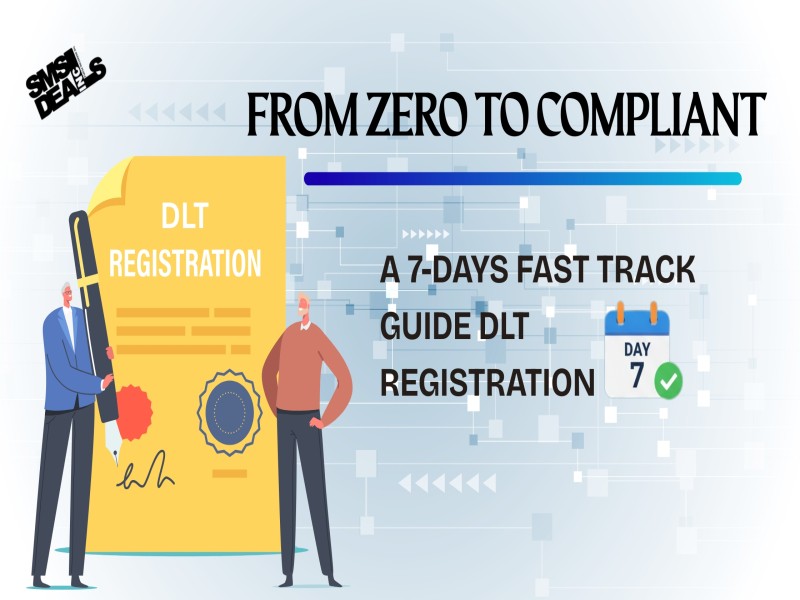
From Zero to Compliant: A 7-Day Fast-Track Guide to DLT Registration
13 Oct-2025 - By Admin 220In India, if your business sends commercial communications—SMS or voice calls—you must register on the Distributed Ledger Technology (DLT) platform, a system mandated by the Telecom Regulatory Authority of India (TRAI). DLT aims to curb Unsolicited Commercial Communication (UCC) and protect consumer privacy. Non-compliance can lead to message failures, delivery disruptions, and even penalties.
The DLT registration process can seem complex, but with a structured approach, you can achieve compliance quickly. This 7-day fast-track guide breaks down the process into manageable steps, ensuring you go from 'zero to compliant' with minimal friction.
Phase 1: Preparation and Entity Registration (Days 1–3)
The initial phase is all about gathering the right documentation and establishing your identity on the DLT network. This is the most crucial step as subsequent approvals depend on it.
Day 1: Document Gathering and Platform Selection
To avoid delays, start by compiling all necessary Know Your Customer (KYC) documents.
Platform Selection: Choose a telecom operator's DLT platform (e.g., Jio, Airtel, Vodafone Idea/Vi, BSNL) to register as a Principal Entity (PE). Registration with one operator is sufficient, as your details are shared across the DLT ecosystem, but some entities choose to register with multiple.
Day 2: Principal Entity (PE) Registration
Navigate to your chosen DLT operator's portal and select the Principal Entity registration option.
Sign-Up: Fill in the basic business and authorized signatory details.
Upload Documents: Upload all the compiled KYC documents.
OTP Verification: Complete the email and mobile number verification.
Fee Payment: Some operators charge a non-refundable registration fee (e.g., approximately ₹5900 inclusive of GST).
Action Point: Submit the application and note down the temporary registration or reference number.
Day 3: Entity ID Approval & Telemarketer Mapping
The PE registration typically takes 48–72 working hours for approval.
Await Approval: Check your registered email and the portal for the status update.
Receive Entity ID: Upon successful verification, you will receive your unique Entity ID. This ID is your primary identifier on the DLT platform.
Map Telemarketer: Immediately link your Entity ID with your chosen Telemarketer/SMS service provider. You will need their unique Telemarketer ID (TM ID) to complete this step—get this from your provider. This step, known as PE-TM Chain Binding, is mandatory for message delivery.
Phase 2: Sender ID and Content Registration (Days 4–6)
Once your identity is verified, you must register your communication identifiers and content.
Day 4: Header (Sender ID) Registration
Headers (or Sender IDs) are the 6-character alphanumeric or 6-digit numeric names displayed as the sender of your SMS.
Select Type: Determine if your Header is Promotional (typically numeric, for marketing), Transactional (alphanumeric, for OTPs, order alerts, etc.), or Service (alphanumeric or numeric, for informational updates).
Apply for Header: Log in to the DLT portal, go to the 'Headers' section, and apply. Ensure the Header name is relevant to your registered Entity name.
Await Approval: Header approvals generally take 24–48 hours.
Day 5: Content Template Registration (Drafting)
Every single message content structure must be pre-approved. This is where most submissions get rejected, so focus on accuracy.
Draft Templates: Draft your message templates, ensuring they fall into the correct category: Transactional, Service Implicit, or Service Explicit (requires explicit customer consent).
Use Variables: Replace dynamic information (names, amounts, OTPs) with variables, such as {#var#}.
Example: "Dear {#var#}, your order no. {#var#} has been shipped."
Strict Guidelines: Avoid marketing language in Transactional/Service categories, maintain correct spelling and punctuation, and keep the message purpose clear.
Day 6: Content Template Submission & Whitelisting
Submit Templates: Upload your drafted templates on the DLT portal and map them to the corresponding approved Header(s).
CTA Whitelisting: If your messages include any Call-to-Action (CTA) elements (like URLs, mobile numbers, or email addresses), you must apply to have them whitelisted on the platform. Provide proof of ownership for any included URLs.
Action Point: Submit the templates and whitelisting requests and await final approval. This can take 1–2 working days.
Phase 3: Final Compliance and Execution (Day 7)
On the final day, you tie up all loose ends and prepare for message delivery.
Day 7: Final Compliance Check and Integration
Verify Approvals: Confirm that your Entity ID, Headers, and all Content Templates are showing an 'Approved' status on the DLT platform.
Share IDs: Share all your approved IDs (Entity ID, Header ID, and Template IDs) with your Telemarketer/SMS service provider. They need these unique IDs to map your messages correctly and ensure delivery.
Test Messages: Conduct a small test run of messages through your service provider, ensuring the correct Template IDs are included in the message payload.
Maintain Records: Establish a system for maintaining digital records of all customer consents, especially for Service Explicit and Promotional messages, as TRAI mandates this.
By dedicating one week to this structured process, you can navigate the complexities of DLT registration effectively. Compliance isn't just a regulatory hurdle; it's a step toward building greater customer trust and ensuring reliable, transparent communication.
